Rapport
Executive summary
In 2012, Bain & Company, in partnership with Kantar Worldpanel, presented its groundbreaking research on the behavior of Chinese shoppers. We discussed the insights we gained from a rare look at what shoppers really do at the point of sale, as opposed to what they say they do. The findings provided a starting point for consumer goods companies to determine the best strategy for growth and profit in the world’s second largest marketplace for their products.
This year we present a second look. We again partnered with Kantar Worldpanel to study the shopping habits of 40,000 Chinese households in the 26 important consumer goods categories we studied the previous year (see Figure 1). Our 2013 analysis allowed us to confirm and refine our previous findings, and provided additional invaluable insights into how shoppers make purchases. These insights will be critical to marketers as they seek to grow their brands in a Chinese market characterized by an economic slowdown and increasing competition. The days of growing a brand just by riding a category wave are coming to an end, especially in top-tier cities. As in more mature markets, brand growth in China will need to come from share gains.
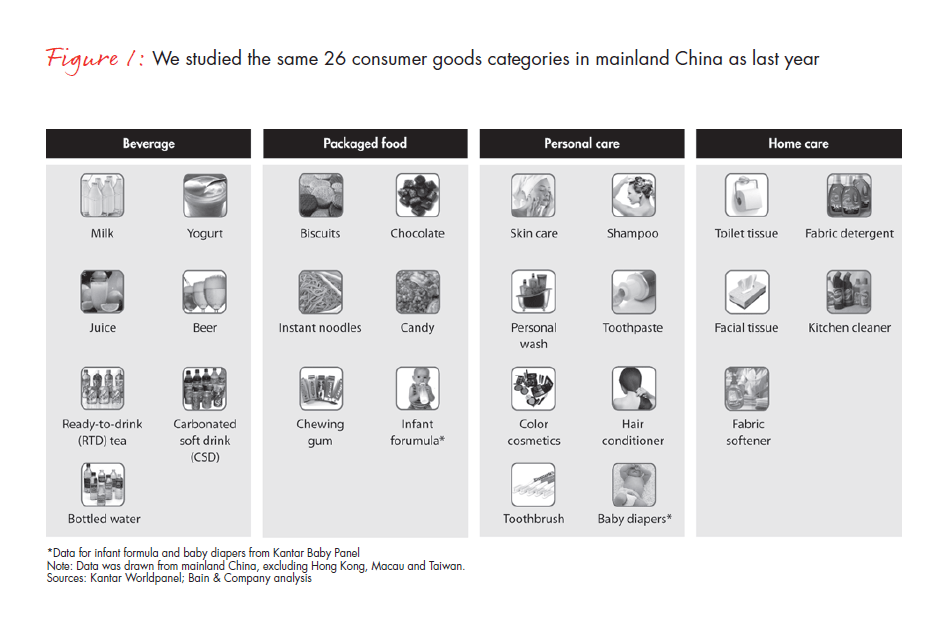
Among the key findings:
- Shoppers showed similar behaviors from year to year across the 26 categories in terms of purchase frequency and number of brands purchased.
- In most situations, shoppers who buy more frequently in a category also tend to buy more brands in that category—choosing different brands for the same occasion or need. We call this tendency “repertoire behavior.” Repertoire behavior prevails in China, but in some product categories shoppers are more loyal— they repeatedly buy one brand for a specific need or occasion.
- We again found a continuum of categories ranging from “heavy repertoire” to “more loyalist.” Indeed, each of the 26 categories earned the same placement along the continuum that it had in the analysis for the 2012 report. Brand strategy should be based on an understanding of where a category falls along the continuum from repertoire to loyalist.
- Although Chinese shoppers buy multiple brands in every category, they display very predictable buying patterns across all categories. This is consistent with the behavior of shoppers in other parts of the world.1
- Given that Chinese shoppers are inclined to buy multiple brands, it is not possible to create big brands by targeting and selling to only a few shoppers in the hope that they will become heavy or loyal buyers—shoppers don’t behave this way. Instead, to build a big brand companies need to sell to as many shoppers as possible.
- Penetration is the most important driver of market share for each of the 26 categories, regardless of where it falls on the continuum from repertoire to loyalist.
- We found that the leading brand in a category had a penetration rate that is approximately 3 to 10 times higher than the average penetration rate of the category’s top 20 brands. The difference in penetration rates is significantly larger than the difference in purchase frequency and repurchase rate for the leading and top 20 brands in the same categories.
- In most categories, brands with higher penetration rates also tend to have higher purchase frequency and repurchase rates. Our analysis found that a category’s leading brand invariably has the highest purchase frequency and repurchase rate. This finding suggests that “niche brands” (brands having a small shopper base that displays an exceptionally high loyalty or buying frequency) don’t exist—the brands that have a small shopper base are simply small brands, whose buyers usually buy less frequently and churn more often. Because products can’t succeed as niche brands, marketers should avoid investing in elaborate consumer segmentation efforts.
- In this study, we chose to apply a particular focus on 10 categories to understand the distribution of purchase frequency for leading and smaller brands. Our in-depth analysis confirmed the importance of penetration over purchase frequency for driving market share. Importantly, it also showed that the majority of shoppers have very low purchase frequency—for both large and small brands.
- The shopper base experiences a high level of churn for all the brands we studied, regardless of a brand’s size.
- On average, the top five brands in a category lose 30% to 60% of their shopper base every year, and these percentages are even higher for small brands. Although brands’ shopper bases and revenues appear stable, this overall stability conceals the fact that a significant number of shoppers are lost and recruited each year.
- Because a brand’s shopper base is a “leaky bucket,” a brand seeking to grow must not only attract new shoppers each year but also replace its lost shoppers with new ones. Because most shoppers have very low engagement with a brand in terms of purchase frequency and repurchase rate, a company needs to find ways to recruit them again each time they go shopping.
The implications of our research are again far-reaching, providing insights that will help marketers shape strategic decisions. The route to success begins with an understanding of a brand category’s position on the continuum from heavy repertoire to more loyalist. Marketers can use this understanding to determine how to increase penetration for their brands. As we will discuss in greater detail, the most effective approach to building penetration depends on whether the category skews toward heavy repertoire or more loyalist:
- Advertising should adjust its focus on the basis of the skew: raising consideration in repertoire categories and increasing preference in loyalist categories.
- The main goal of innovation in repertoire categories is to create new consumption occasions and reach new consumer groups. In loyalist categories, innovation should seek to introduce more premium products to entice consumers to trade up.
- Store displays and activations for repertoire categories should be focused on increasing visibility throughout the store. For loyalist categories, the focus should be on maintaining good visibility on the main shelf.
Full report
This report presents a second in-depth look at Chinese shoppers, bringing their purchasing behaviors into even sharper focus. For consumer goods makers in search of growth, the findings once again help fill a serious void, providing detailed data and in-depth analysis of shopper behavior—information that has been limited until now.
Our studies provide much richer analysis and sharper insights into shopper behavior than traditional market research allows. Instead of simply asking questions about past purchases and future intentions, Kantar Worldpanel armed shoppers (again in 40,000 households) with inhome scanners that tracked their actual purchases in real time. Together, we again looked at detailed records in the same 26 selected consumer goods categories. For the first time this year, we augmented this overall research with a refined analysis of 10 categories we deemed worthy of further focus. This fine-tuning allowed us to reach several important—and at times, surprising—conclusions.
The comprehensive 2013 report covers all Chinese city tiers and life stages. Shoppers from 373 cities in 20 provinces and four major municipalities participated.2 The cities reflect the vast range of shopping options available in China today, from the modern trade that flourishes in Tier-1 cities (hypermarkets, supermarkets and convenience stores) to the traditional trade that is common in smaller modern cities (mom-and-pop grocery shops, specialty stores and department stores). Also included in the study: China’s young but burgeoning e-commerce market. The study had a broad scope—for example, we tracked older, married shoppers buying shampoo in the aisles of a Guangzhou hypermarket and young students purchasing chewing gum in tiny mom-and-pop stores in cities like Lijiang.
The categories we analyzed span beverages, packaged foods, personal care and home care—the four largest consumer goods groups, which account for more than 80% of China’s consumer goods market. And the brands we studied represent more than 50% of these four groups in China.
In our 2013 report on Chinese shoppers, we confirmed and expanded our insights regarding their behavior, once again finding that the 26 categories lie along a continuum from “heavy repertoire” to “more loyalist” (see Figure 2). (The 2013 report analyzed data collected in 2012, whereas the 2012 report analyzed data collected in 2011.)
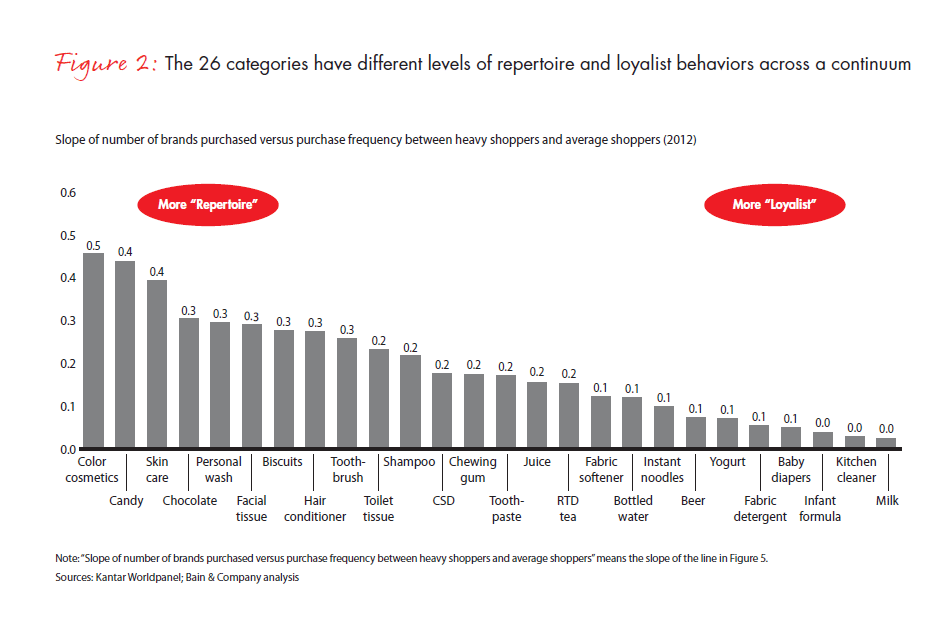
Shoppers exhibit repertoire behavior when they choose multiple brands within a category for the same occasion or need. The more frequently that shoppers buy in a repertoire category, the more brands they tend to buy in that category. And heavy shoppers of a particular brand tend to be heavy shoppers of other brands in that category. Strong repertoire categories include skin care, biscuits and chocolate.
In contrast, shoppers demonstrate loyalist behavior when they frequently buy one brand in a category for a specific need or occasion. They tend to buy the same brands even when they buy more frequently in a category. And heavy shoppers of a particular brand are not heavy shoppers of other brands in that category. Strong loyalist categories include infant formula, baby diapers and milk.
Understanding where a category falls along the continuum from repertoire to loyalist should be at the center of any brand strategy.
Shopper behavior is consistent in both years
Although brands are important to Chinese shoppers, these shoppers don’t think about one brand very often. Across the 26 categories we studied, the average purchase frequency of any particular brand is very low: less than five times per year. Even at the category level, the average purchase frequency rarely exceeds once per month. Shoppers’ very low engagement level with all brands should be sobering news for marketers who believe that the key to success is devoting tremendous effort and resources to getting shoppers to love their brands.
Our 2013 study confirmed this finding when we again looked at how frequently shoppers bought the top three brands in a category (see Figure 3). For example, the average purchase frequency of the top three ready-to-drink tea brands is only 3.4 times per year; for the top three beer brands, only 3.8 times. This low purchasing frequency indicates that Chinese shoppers don’t often have just one brand in mind, despite what marketers sometimes think.
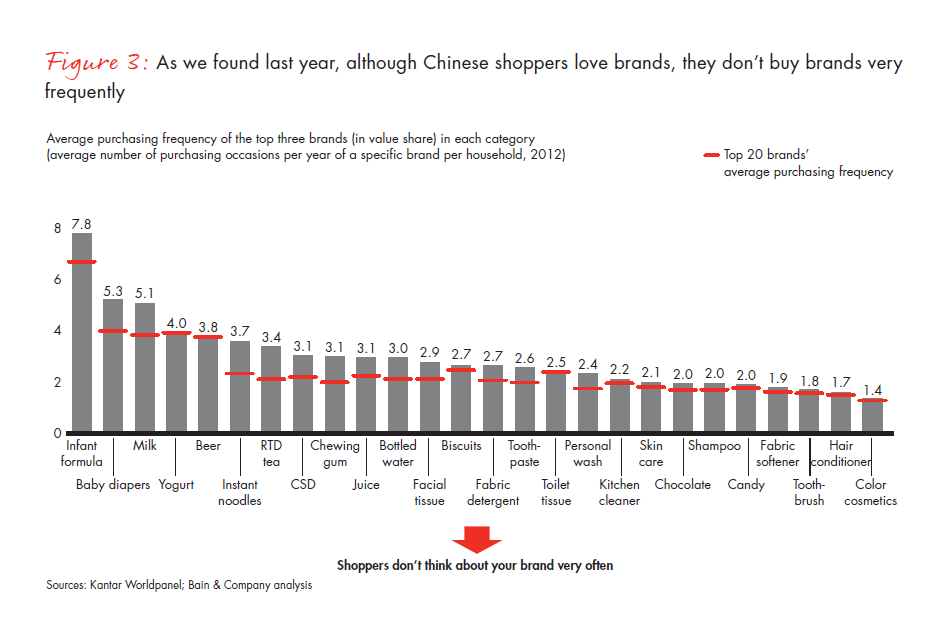
Across the 26 categories, we found very similar behaviors in both years, in terms of number of brands purchased and the frequency of purchase. In both years, shoppers tended to purchase more brands when they purchased more frequently—that is, they tend to exhibit repertoire behavior (see Figure 4).
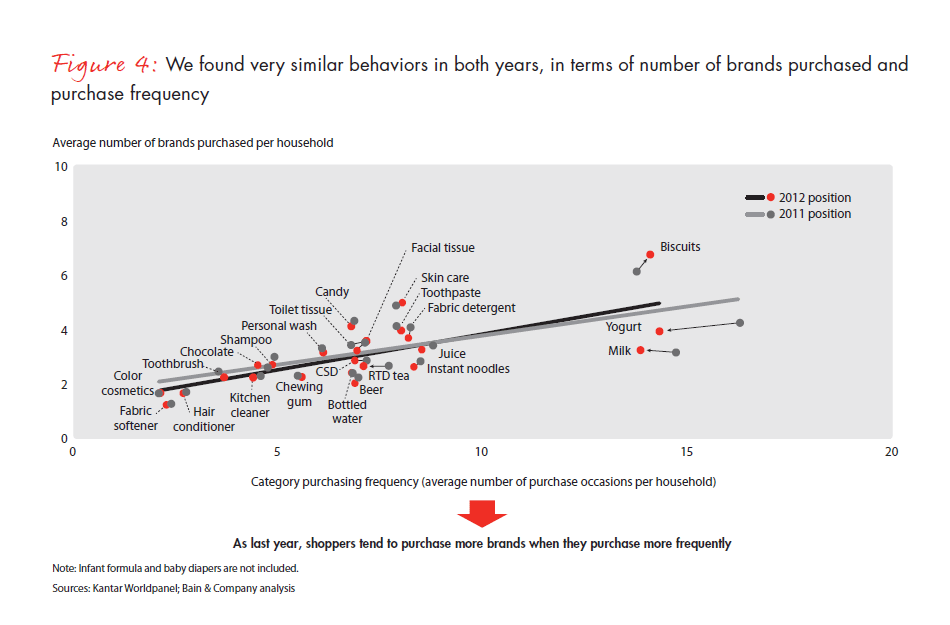
Heavy shoppers not only buy more brands than average shoppers, they also buy more brands as they purchase more frequently in most categories. As frequency increases, we found, the variation in the number of brands that shoppers buy across the 26 categories widens (see Figure 5). In other words, shoppers who increase their purchasing within most categories also try different brands in the category. For example, the heavy shoppers in the candy category—those representing the top 20% of candy purchasers who buy most frequently— bought approximately twice as many brands as all shoppers in that category. These heavy shoppers of candy purchase 15.6 times per year and choose 8.1 brands, whereas the average candy shoppers purchase only 6.8 times per year and choose 4.1 brands.
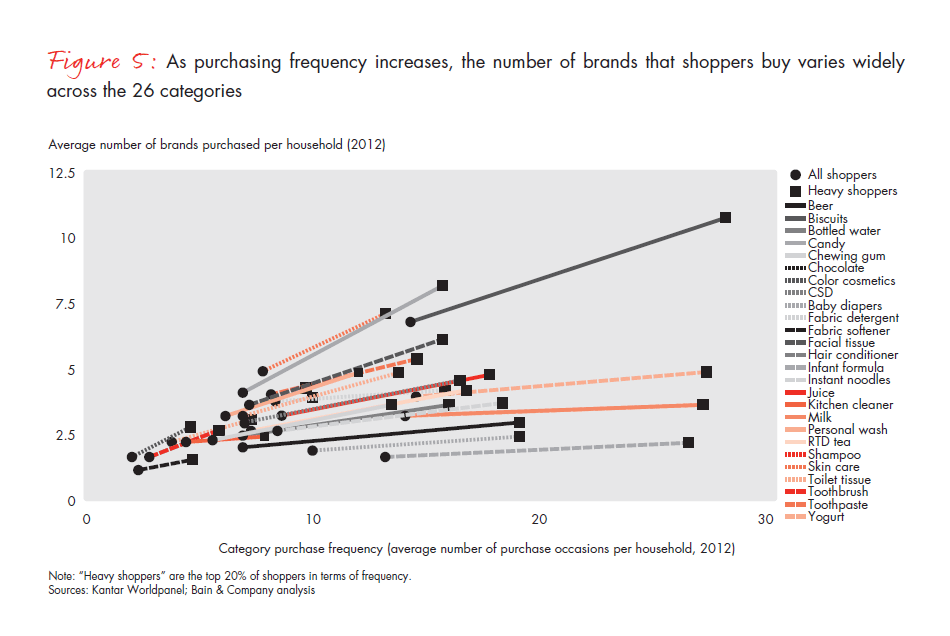
In categories with stronger repertoire behavior, brands’ heavy shoppers are often heavy shoppers of competing brands as well. As an example, consider Minute Maid’s heavy shoppers. The 20% of Minute Maid shoppers who are the product’s most frequent purchasers in China contribute approximately 50% of the brand’s sales value in the country. These shoppers also contribute significantly to competing brands’ sales value— 20% or more in several cases. Indeed, Minute Maid accounts for only approximately 35% of its heavy shoppers’ total spending on juice (see Figure 6).
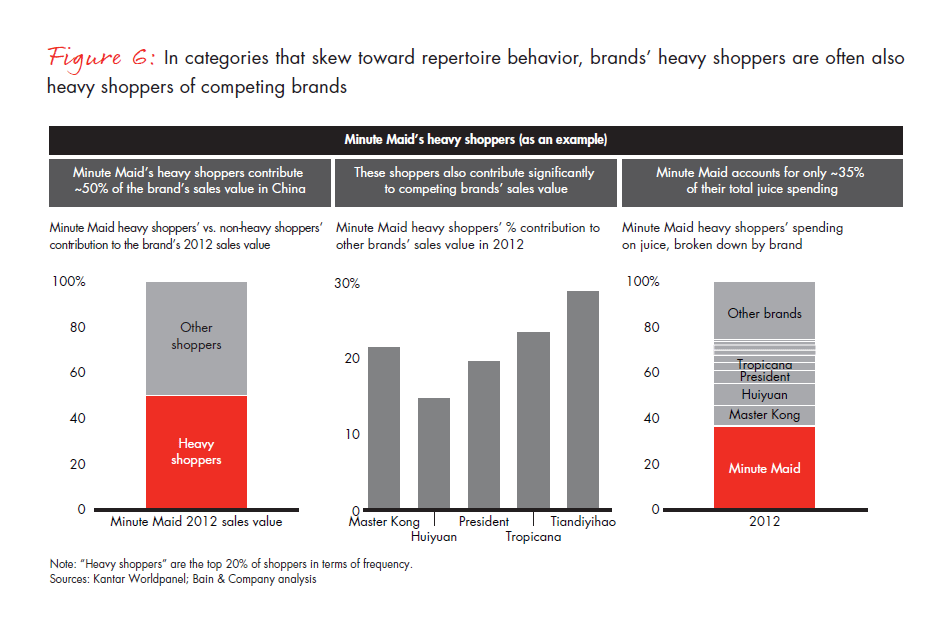
As one would expect, in categories with stronger loyalist behavior, a brand’s heavy shoppers allocate most of their category spending to that brand. Tsingtao’s experience illustrates this. Its heavy shoppers contribute approximately 60% of its sales value. But these shoppers don’t contribute much to competing brands’ sales value—less than 10% in most cases. And Tsingtao accounts for about 65% of these shoppers’ total beer spending (see Figure 7).
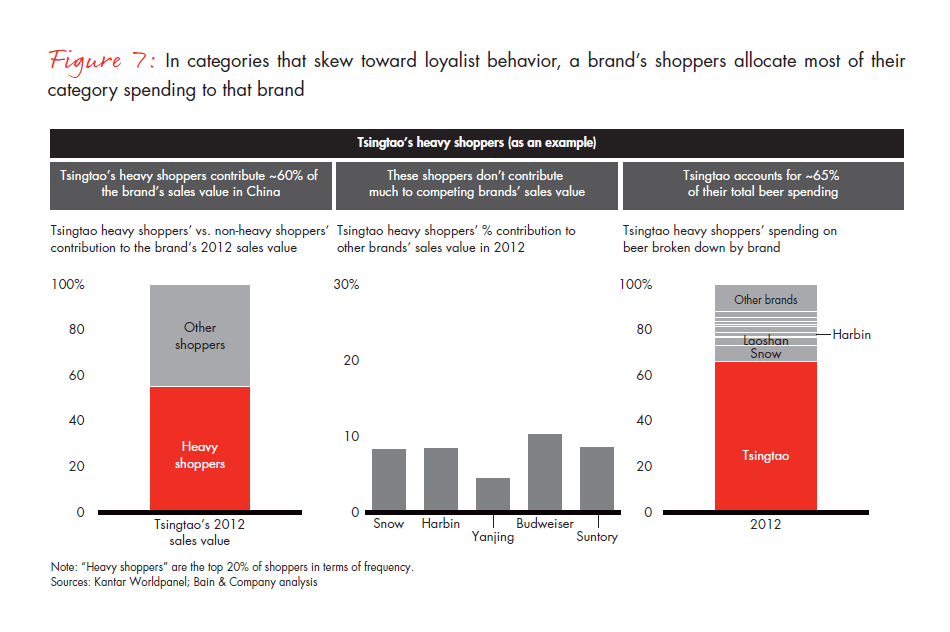
Penetration is paramount
Our latest study confirmed that penetration is the most important driver of market share across all 26 categories. (“Penetration” [expressed as a percentage] is the number of households that bought a brand or category at least once during the year divided by the total number of households in the study.) Leading brands always have much higher penetration rates than the average rate for brands in their category. Specifically, we found that the leading brand’s penetration rate is approximately 3 to 10 times higher than the average penetration rate of the top 20 brands in the category (see Figure 8). The difference in penetration rates is significantly larger than the difference in purchase frequency and repurchase rate for the leading and top 20 brands in the same categories. (see Figure 9).
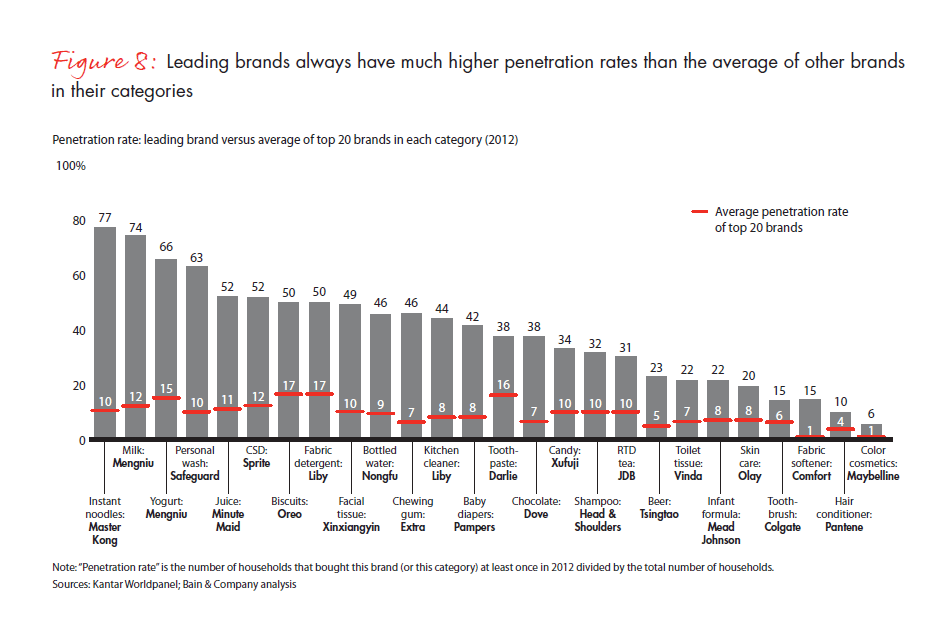
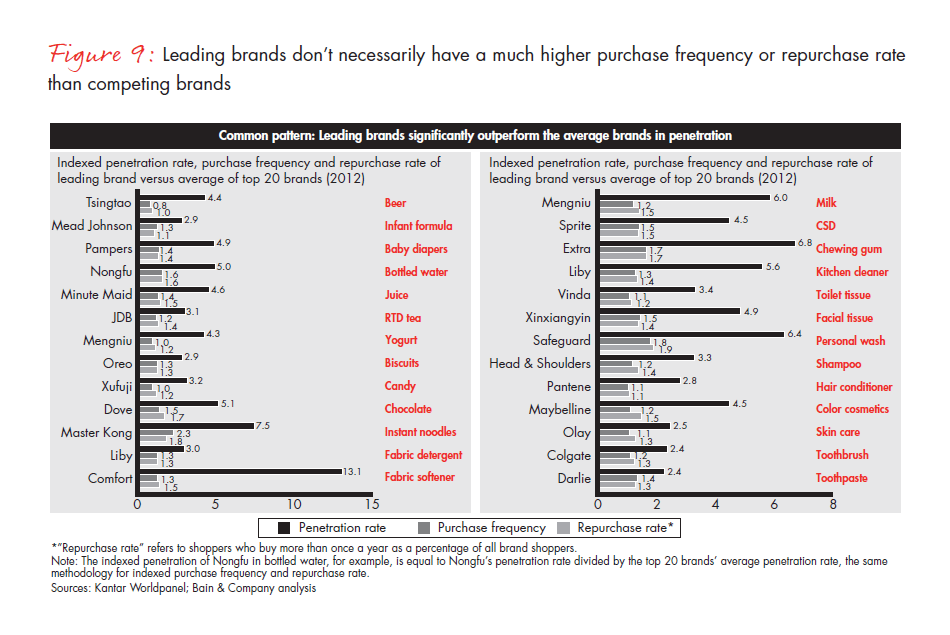
The importance of penetration over purchase frequency for driving market share was confirmed when we refined our analysis across 10 focus categories to understand the distribution of purchase frequency for leading and smaller brands. The results are telling: Most shoppers have very low purchase frequency at the category and brand level. Across all 10 focus categories, approximately 40% to 60% of shoppers purchase a brand only once a year, whereas approximately 70% to 80% of shoppers purchase no more than two times per year.
Within each category, low-frequency shoppers are very critical to the shopper base and contribute significantly to revenue. This is true for both leading and smaller brands.
For leading brands, approximately 20% to 55% of revenue is contributed by shoppers who purchase no more than two times per year. As an example, consider the fabric detergent category. Across all brands in the category, most shoppers made fewer than three purchases in 2012 and nearly half of them made only one purchase (see Figure 10). For the leading brand, Liby, approximately 30% of revenue was contributed by shoppers making no more than two purchases per year (see Figure 11).
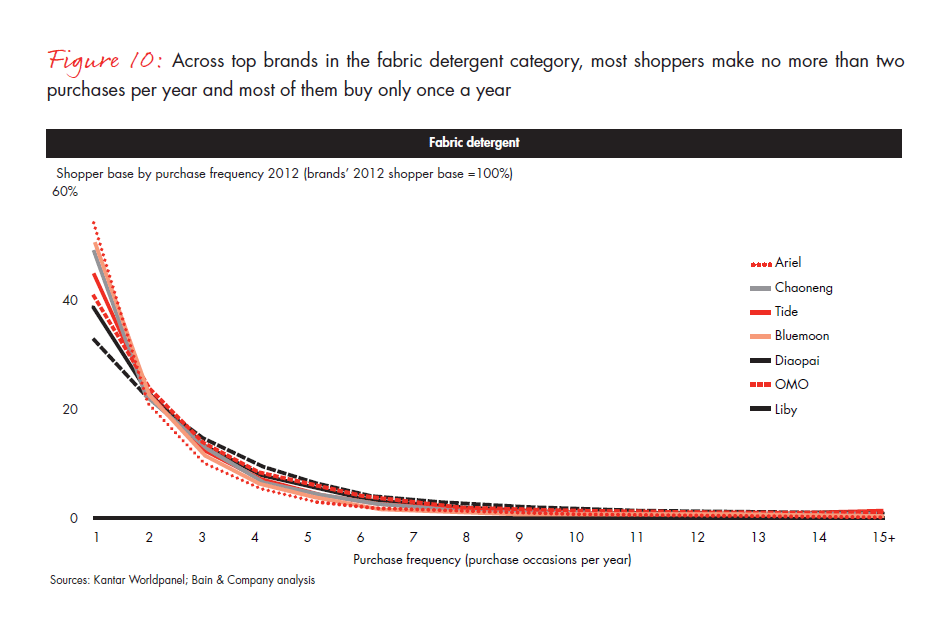
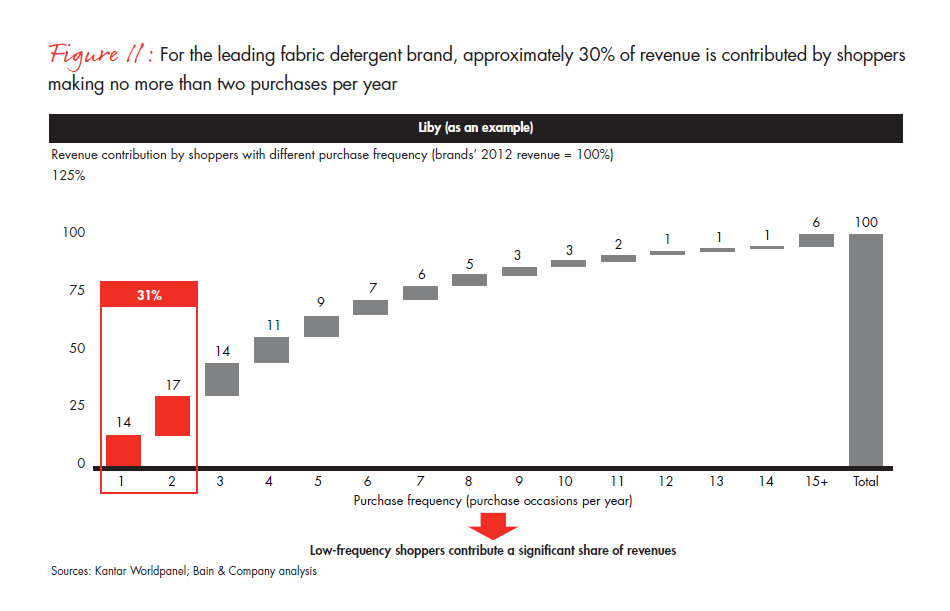
Low-frequency shoppers are even more critical to revenue for smaller brands. In each of the 10 focus categories, the average revenue contribution by shoppers with no more than two purchases per year for the top seven brands exceeded their revenue contribution for the leading brands (see Figure 12). Among fabric detergents, the three leading brands—Liby, OMO and Diaopai—have lower revenue contribution from low-frequency shoppers than four smaller brands: Bluemoon, Tide, Chaoneng and Ariel (see Figure 13).
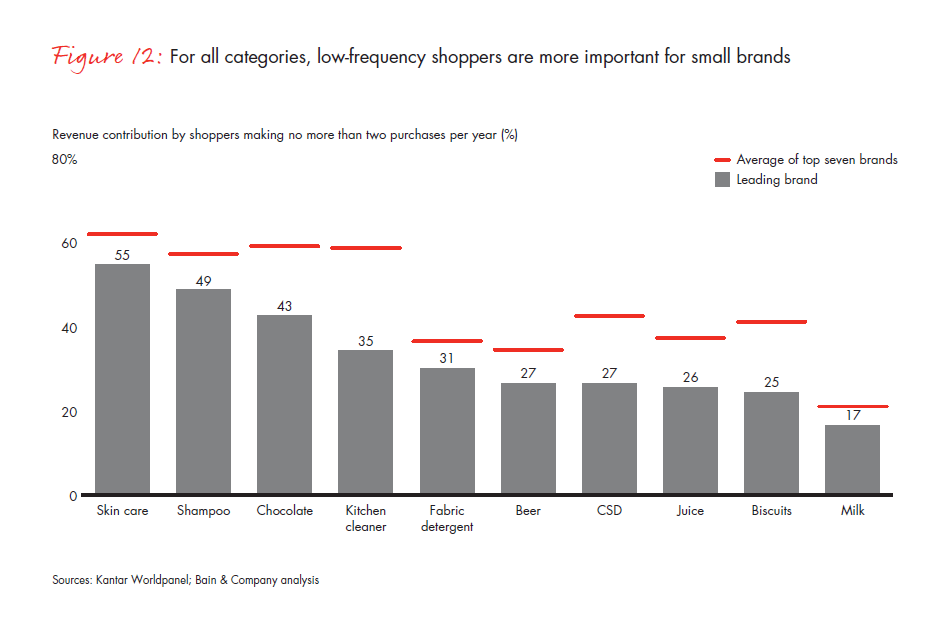
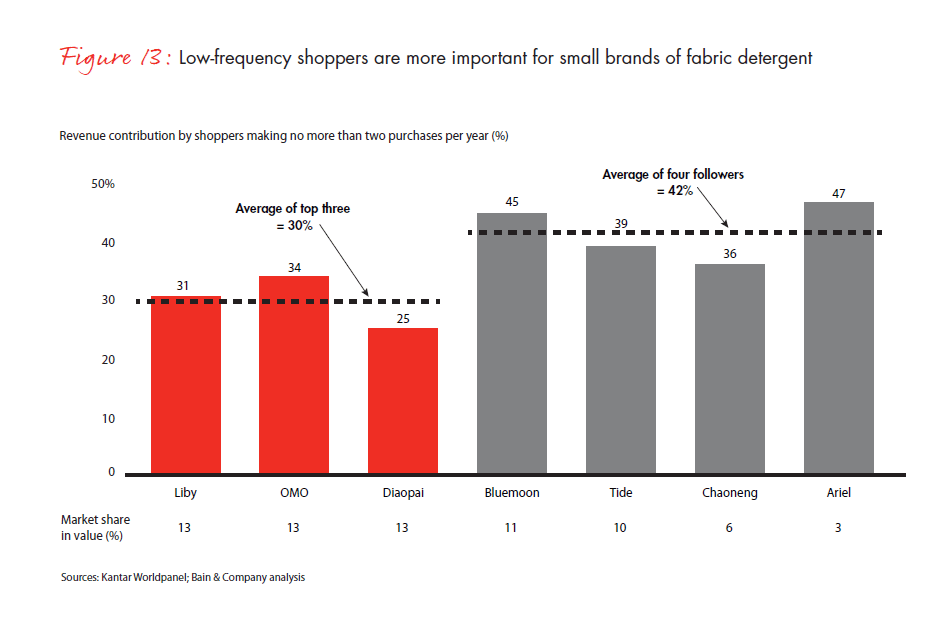
Given the importance of low-frequency shoppers, penetration is the key to growth for any brand. The fabric detergent and shampoo categories illustrate the high correlation between market share and penetration (see Figure 14). Even when looking at all 26 categories, the correlation between market share and penetration is still very high (see Figure 15).
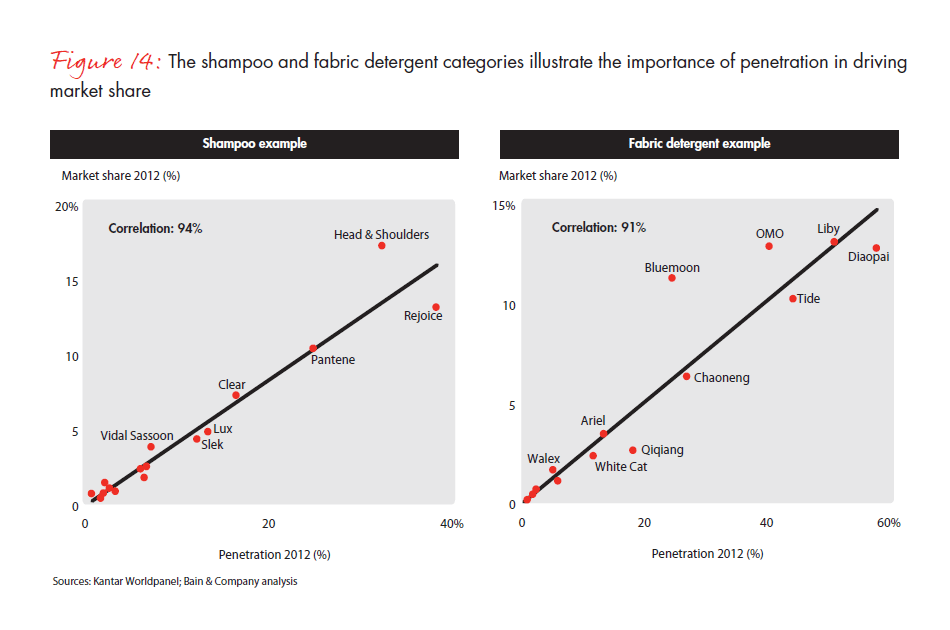
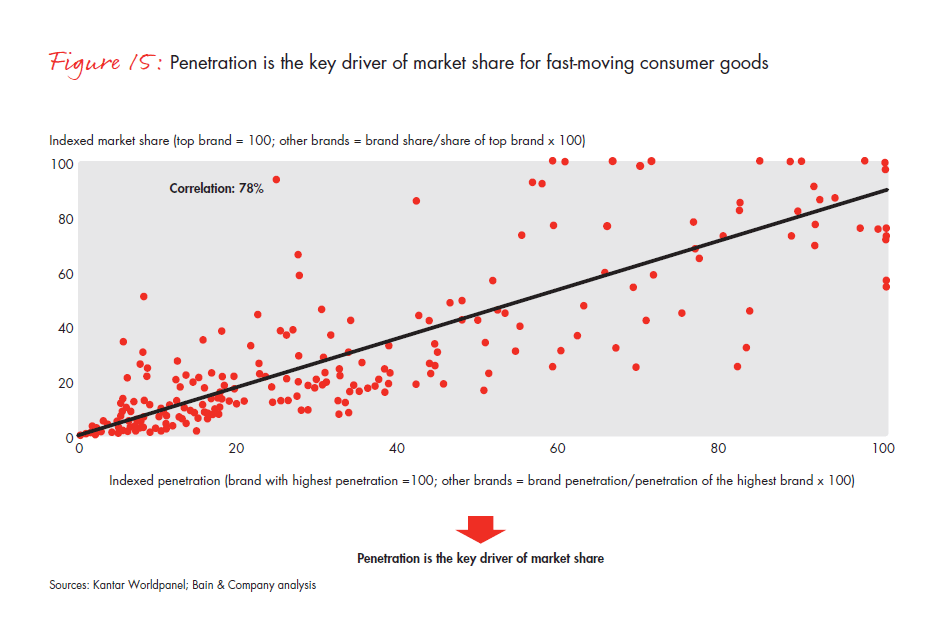
What’s more, in most categories, brands with higher penetration rates also tend to have higher purchase frequency and a higher repurchase rate. In the properly defined categories we studied, we did not find a brand that had a higher purchase frequency or repurchase rate than the category’s leading brand. In the fabric detergent category, for example, higher penetration for the leading brands also drove higher purchase frequency and repurchase rates (see Figure 16). This suggests that “niche brands” with an exceptionally loyal shopper base don’t really exist—brands with a small shopper base are simply small brands, whose buyers usually buy less frequently and churn more often. (Category definition is critical to accurately making this assessment. Properly defining a category involves analyzing shoppers’ overlap across categories and brands to assess whether the shoppers consider these categories as one or several, and whether they consider brands as direct competitors. For example, are laundry liquid, laundry bar and laundry powder one or several categories? Is beer a national category or a regional category? Does Mizone compete with Nongfu in drinking water?)
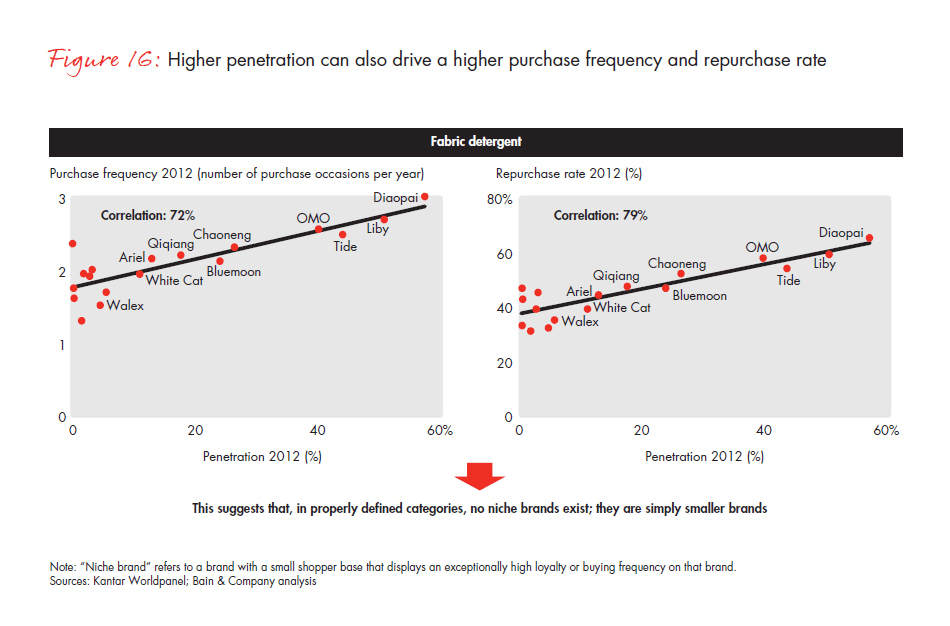
Across all categories this analysis leads to the inescapable conclusion that penetration is paramount. Companies need to sell to as many shoppers as possible to build a big brand. Following from this finding, companies cannot expect to create big brands by targeting and selling to only a few shoppers in the hope that those shoppers will become heavy or loyal buyers. Shoppers simply don’t behave that way.
A brand’s shopper base is a “leaky bucket”
Reinforcing the importance of penetration, our study also found that brands’ shopper bases are not stable. The shopper base of all brands we studied experiences a high level of churn, regardless of a brand’s size.
Marketers who think that their shopper base and revenue are stable should stop and take note—this apparent stability is actually an illusion. Indeed, the rates of loss and recruitment of shoppers can be significant. For example, Head & Shoulders’s shopper base increased by 3% from 2011 through 2012, which appears quite stable. However, the brand lost 45% of its 2011 shopper base, while at the same time adding new shoppers that represented 48% of the 2011 base. Its sales value increased by 11%, but only 6% of the increase came from stable shoppers. Departing shoppers represented 35% of sales value, while newcomers represented 40% (see Figure 17).
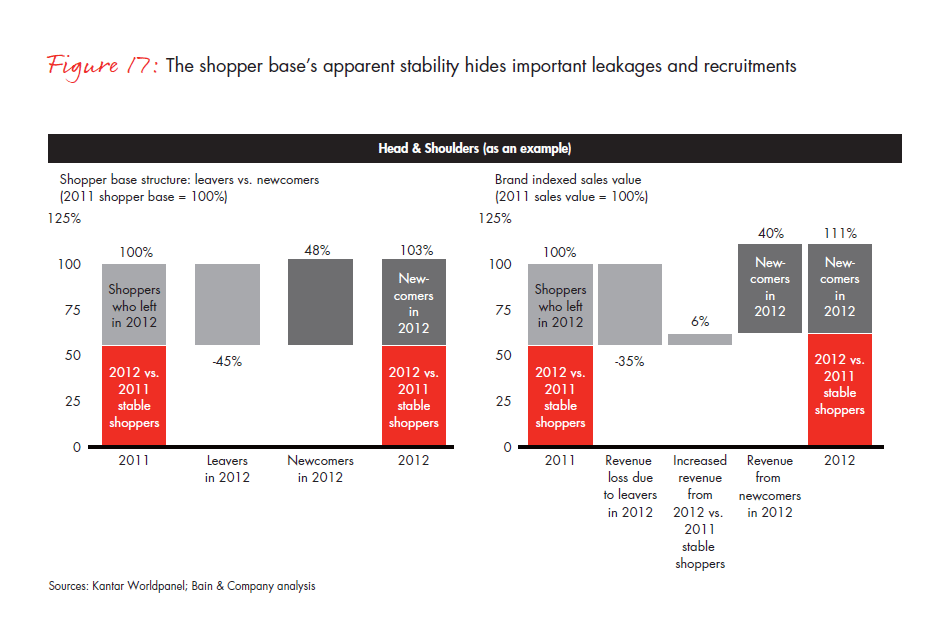
On average, the top five brands in each of our 10 focus categories lost 30% to 60% of their shopper base in 2012 compared with 2011. These lost shoppers represented, on average, 20% to 50% of the top five brands’ revenues in 2011 (see Figure 18). Similarly, we found that, on average, the top five brands recruited new shoppers amounting to 40% to 80% of their shopper base. Sales to these new shoppers represented, on average, 35% to 80% of the brands’ 2011 revenues (see Figure 19).
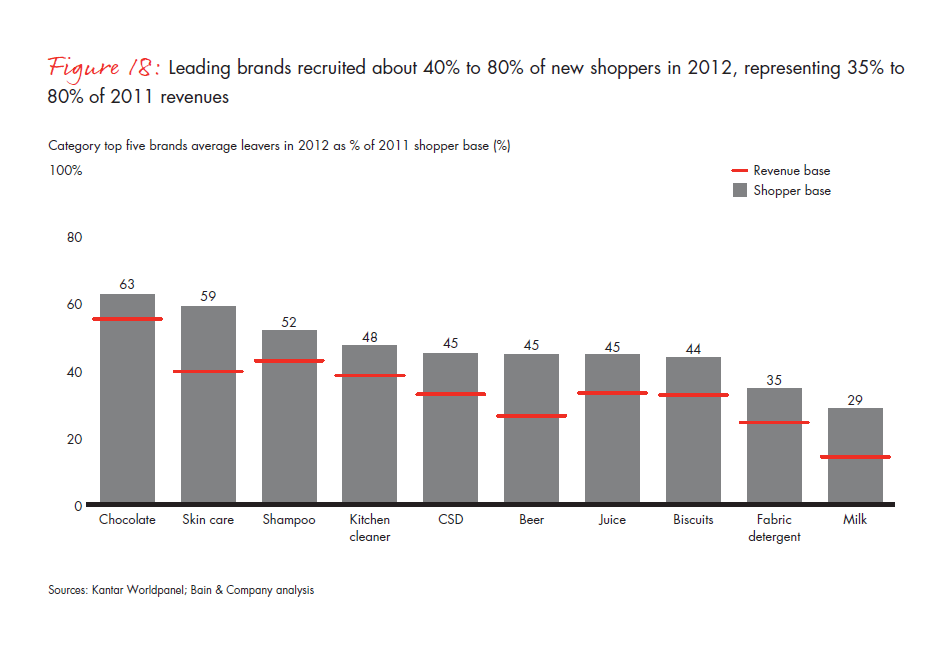
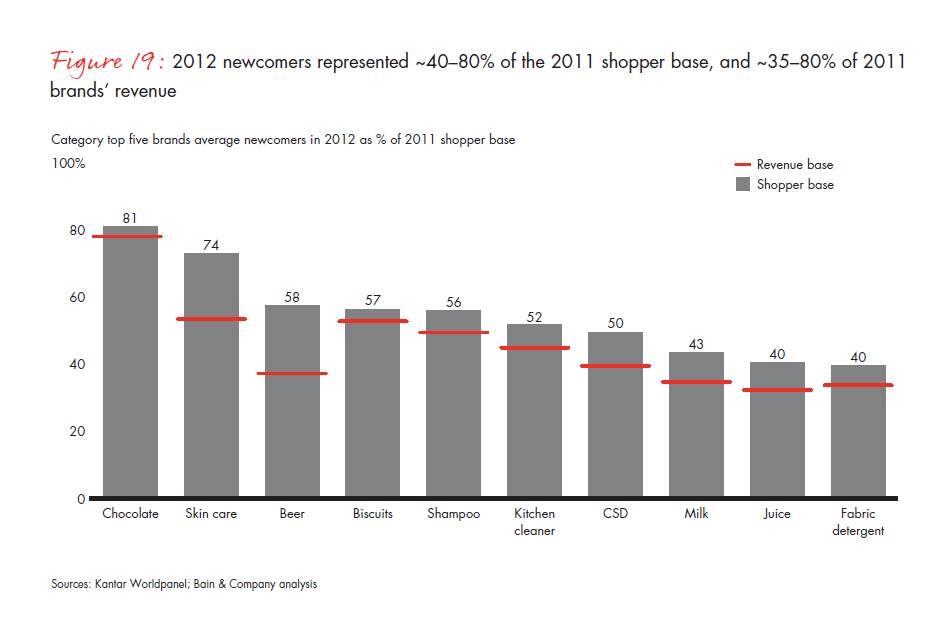
We also found that smaller brands tend to have higher churn rates than leading brands. This reinforces the view that niche brands do not exist in China (see Figure 20). Small brands simply have fewer buyers, who buy less frequently and who churn more often. As one might expect, we also found that the churn rate in loyalist categories, on average, appears to be lower than in repertoire categories.
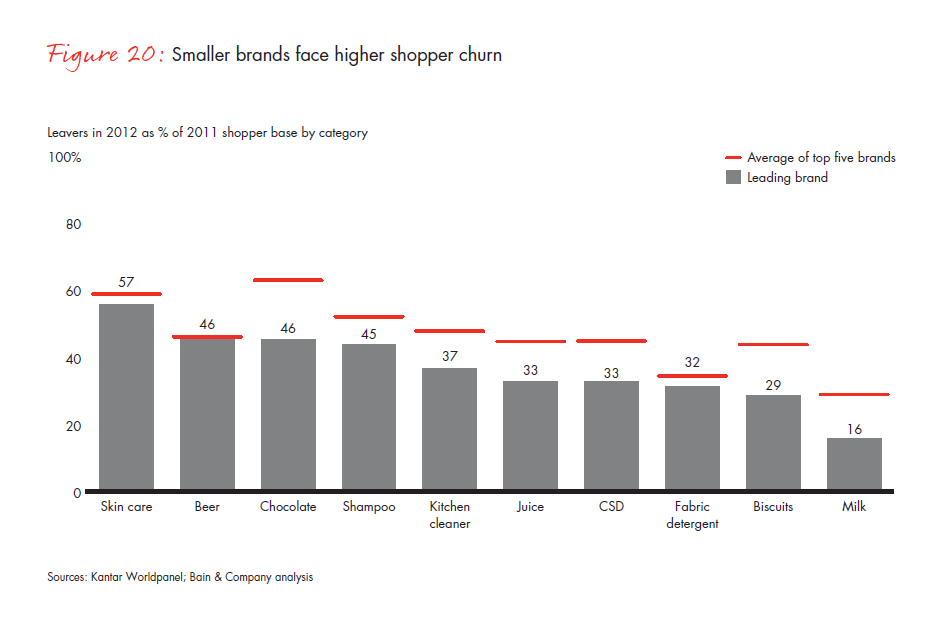
This analysis demonstrates that a brand’s shopper base is like a “leaky bucket.” For a brand to grow, a company needs to recruit new shoppers every year to compensate for those it loses, further emphasizing the importance of penetration. Because most shoppers have very low engagement with a brand (in terms of purchase frequency and repurchase rate), a company needs to find ways to recruit potential buyers again each time they go shopping.
Knowing a brand’s place on the repertoire-to- loyalist continuum is vital
Our findings demonstrate that across all categories, whether characterized by heavy repertoire or more loyalist behaviors, the most important factor in growing brands is to drive penetration. By applying the right ways to build penetration, companies can capture revenue from the low-frequency shoppers who represent the bulk of any brand’s revenue base. They can also regularly recruit new shoppers to refill the base’s “leaky bucket.” And they can drive higher rates of frequency and repurchase among the shopper base.
A major implication is that marketers must identify the barriers to penetration and address a key question: “Why are shoppers not buying my brand?” To provide an answer to this question, we believe that shopper research should focus on those who have yet to purchase a brand rather than the brand’s existing shoppers.
Recognizing the importance of penetration for all types of categories is just the starting point for success. To build on it, companies must understand that the differences between repertoire and loyalist categories create the need for different approaches to increasing penetration. That means a company must identify a brand category’s position on the continuum between “heavy repertoire” and “more loyalist” before deciding how to grow penetration for that brand.
To determine whether a category tends to skew more toward repertoire or loyalist behavior, we used the data from the analysis shown in Figure 5 (the number of brands purchased versus the purchase frequency for heavy and average shoppers) to compare the 26 categories. The slope of the curve for a category in this analysis can be used to assess the degree of repertoire behavior for the category relative to the other categories. A steeper slope indicates that a category is “heavy repertoire” (for example, candy), whereas a flatter slope indicates that a category is “more loyalist” (for example, yogurt) (see Figure 2).
To confirm the analysis shown in Figure 2, we compared the results for the 10 focus categories with the level of churn in each category’s shopper base. As we expected, the categories we identified as most heavy repertoire were also more likely to have a higher level of churn (see Figure 21).
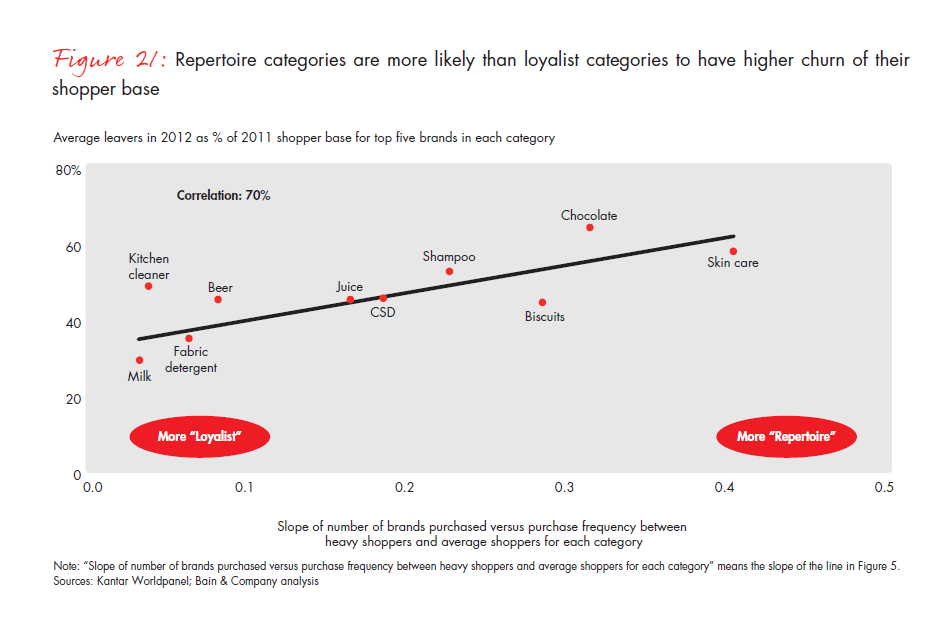
In some cases, the degree of repertoire behavior for a category may be unclear after these two analyses. In the second analysis, for example, the kitchen cleaner category (a stronger loyalist category in the first analysis) has a higher churn rate than the biscuits category (one of the heavier repertoire categories). What’s more, the carbonated soft drink (CSD) category falls in the middle of the continuum in both analyses.
To clarify a category’s nature, marketers can analyze share of wallet for heavy shoppers of the category’s leading brand. (“Share of wallet” is the percentage of a shopper’s spending in a category that’s devoted to a given brand.) A leading brand’s share of wallet for heavy shoppers is typically higher for loyalist categories. For example, this analysis shows that kitchen cleaner is a stronger loyalist category and that biscuits is a heavier repertoire category, consistent with the first analysis of the continuum. The share of wallet for Sprite, the leading CSD player, suggests that this category skews toward repertoire behavior (see Figure 22).
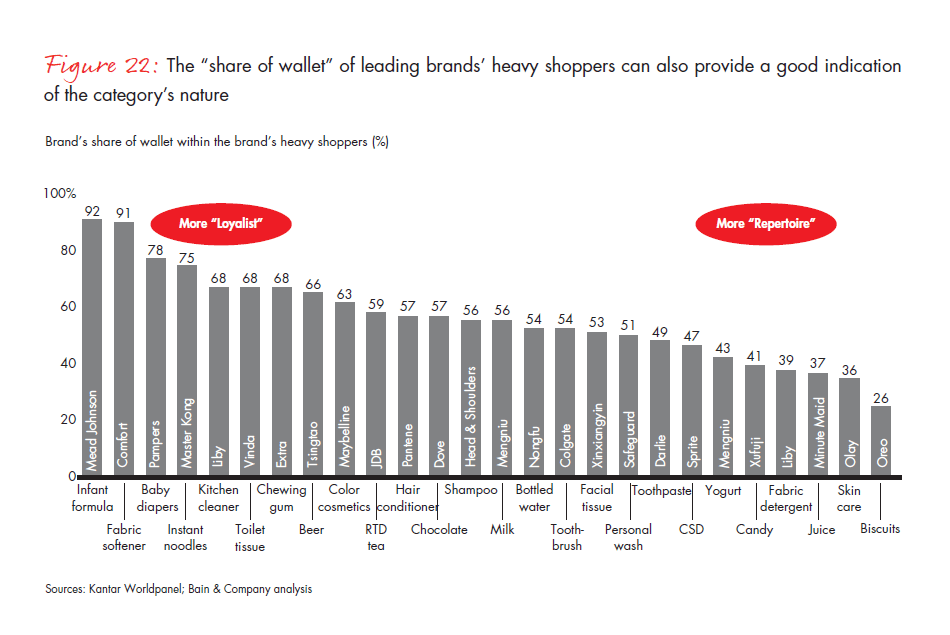
Rules of the road
Armed with an understanding of a brand category’s position on the continuum, marketers can choose the right approach to building penetration.
In categories with stronger repertoire behavior, marketers can drive penetration by taking the following actions:
- Build consideration first. Repertoire category shoppers consider multiple brands when they shop. A company must ensure that its brand is one of the brands that shoppers consider. This can be achieved by investing in the right “above the line” marketing (like TV commercials), focusing on distinctive brand assets and making the brand top-of-mind for specific needs and occasions. For example, Head & Shoulders has consistently invested heavily in above-the-line marketing to promote the concept of “dandruff control” and to build strong consideration.
- Achieve perfect in-store execution, so that consideration translates into penetration. Because shoppers buy so infrequently, wide distribution across channels is important. High levels of “below the line” marketing (like in-store sales promotions) and trade spending are also needed to ensure “constant confrontation” with the shoppers at the point of sale. The in-store focus should be on superior visibility and distinctiveness. This often means that the brand needs to be present in multiple locations in the store, not just on the main shelf. Store “hot spots,” such as shelf ends and check-out counters, should be primary location targets.
- Use innovations in products and packaging to create new consumption occasions and allow the brand to reach new consumer groups. Examples include promotion packs, seasonal packs and products available on other parts of the shelf. Oreo has pursued this approach by offering multiple formats of its biscuit (sandwich, wafer and mini) and multiple price packs.
In categories with stronger loyalist behavior, marketers can drive penetration in the following ways:
- Build preference, not just consideration. Marketers should strive to make a brand the preferred brand for shoppers and to create high switching costs. This can be accomplished through above-the- line marketing, as well as through specific shopper recruitment programs involving free trials for a period of time.
- Be visible and dominant on the main shelf. For loyalist brands, it is not necessary to activate shoppers continually or to be present outside the main shelf. Shoppers can be expected to find the brand they prefer. For example, Pampers, the baby diapers category’s leading brand, always has dominant shelf space with very good in-store visibility on the main shelf.
- Use innovations to get shoppers to trade up to premium offerings. By keeping a step ahead of the competition with product innovations, companies can use shoppers’ loyalty as the foundation for driving higher revenue through purchases of more expensive products. For example, Bright has successfully launched a premium-priced, ambient yogurt (called Momchilovtsi) based on imported lactobacillus to address the needs of consumers for high-quality products.
In all categories, marketers can apply Bain & Company’s effective approach to growing brands, developed on the basis of our extensive research in China and other markets:
- Identify the rules of the category. This entails understanding the category definition based on repertoire versus loyalist behavior, profit pool dynamics and an analysis of the drivers of share gains and losses across the category’s brands.
- Pick the right “battles” based on the category’s rules. Decide where to play (for example, in terms of brands, needs and occasions, price tiers, channels and locations), the targets for revenue and profits, the resource requirements and the business model. It is also critical to define where not to play—for example, which brands to deprioritize—and to accept the resource allocation implications. Too often, we see companies decide to deprioritize a brand but then continue to make marketing investments and set high revenue-growth targets.
- Define the right offer. The concept for the brand should be defined on the basis of dimensions such as saliency, hierarchy, identity, price positioning, the optimal SKU range and the role of innovation.
- Design the winning activation model for the offer. Develop insight-based strategies for the mix of above-the-line and below-the-line marketing and activation levers. These include media and trade spending, shelf locations, promotional activities and guidelines for perfect in-store execution.
Transitioning from opacity to clarity in your understanding of Chinese shoppers will be critical to developing a strategy that will help your brands grow and gain share. Outpacing the competition in China requires building penetration, given the low level of shopper engagement as reflected in shoppers’ low purchase frequency and high churn rate. To counter this, brands in all categories must recruit shoppers during every shopping occasion—at the very least to replace the shoppers inevitably lost through churn. With a solid understanding of a category’s position on the continuum from repertoire to loyalist, marketers can take the right steps to attract new shoppers to their brand. These findings from our 2013 groundbreaking study of Chinese shoppers provide valuable insights to executives seeking the route to success in this complex market, which faces slowing growth and intensifying competition.
Bruno Lannes is a partner in Bain’s Shanghai office and leads the firm’s Consumer Products and Retail practices for Greater China. Mike Booker is a partner in Bain’s Singapore office and leads the firm’s Consumer Products and Retail practices for Asia.
1 The patterns we observed are consistent with the theories developed by Professor Andrew Ehrenberg in the late 1950s and have been demonstrated to hold true in a broad variety of categories and markets. These patterns are currently being further studied and refined by the Ehrenberg-Bass Institute for Marketing Science.
2 Kantar Worldpanel’s city-tier definitions are based on China’s administrative definitions. Beijing, Shanghai and Guangzhou are Tier 1 cities; 24 provincial capitals and a handful of prosperous prefecture cities, such as Shenzhen, Dalian, Chongqing and Qingdao, are Tier 2 cities; 228 prefecture cities are Tier 3 cities; 322 city-associated districts and county-level cities are Tier 4 cities; and 1,300 counties are Tier 5, without coverage in Inner Mongolia, Ningxia, Gansu, Qinghai, Tibet, Xinjiang and Hainan provinces. The 373 cities in the study are a representative sample of all 1,877 cities.





















